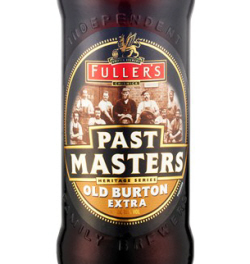Top Tastings 2012
ABV: 7.3%
Origin: London W4, England
Website: www.fullers.co.uk
Burton Ale is one of the great near-lost beer styles, and one that has intrigued certain beer writers (including myself) thanks in part to its difficult to explain contemporary obscurity. Most beer enthusiasts who read the occasional book or blog can tell you a (not necessarily accurate) thing or two about the history of porter or India pale ale, and if you mention Burton will probably assume the latter.
But in fact Burton ale was a distinctive style on its own account, different from pale ale. Although it originated or was perfected in the great brewing centre of Burton upon Trent, Staffordshire, in the days before the regulation of designations of origin it became a generic term for beers in the style wherever they were brewed. And it remained widely consumed right into the 1950s as what beer historian Martyn Cornell describes as “one of the three most popular draught beer styles in Britain” – by then more appreciated in London than in its Midlands homeland.
Burton was a dark, sweetish beer already around before pale ale took off in the town, originally made from brown malt in the days before pale malts became widespread and affordable. Like most beers it was later modified to fit the now ubiquitous practice of basing beer recipes on pale malt, with additions of coloured and speciality malts as required. It therefore became paler in colour, though still brown, giving rise to the confusing term Burton Pale Ale (BPA) – pale in comparison to the old brown malt version but still notably darker than the beers we now think of as pale ales.
Like porter, Burton was originally made in a variety of strengths, including very strong versions which at one point were widely exported, but by the time the first stages of the current beer revival kicked off in the 1970s, it had fallen from favour so comprehensively it was near-completely forgotten. It didn’t help that the few remaining Burtons to survive now hid under other names.
The most familiar is Young’s Winter Warmer, a cask London Burton of moderate strength renamed in 1971 and still regularly brewed today as a tasty seasonal by Wells & Young’s. A BPA is also one of the components of Greene King’s blended bottled speciality Strong Suffolk but hasn’t been sold in its own right for decades.
Only in the past few years has the history of Burton Ale been rediscovered, though revivalist experiments remain rare even among brewers who make a habit of such things. It was particularly exciting, then, when John Keeling announced he was dusting down a 1931 Burton recipe for the third entry in Fuller’s Past Masters series of revived beers from the archive.
Old Burton Extra is a relatively strong version of the style at 7.2%, made from pale and crystal barley malts boosted by maize and brewing syrup. The hops are a traditional combination of English Fuggles and Goldings used both in the copper and to dry hop the beer.
The result is a rich deep Burgundy brown with a thick yellow beige head. There’s sultana and chocolate on a rich, smooth, malty and slightly spicy aroma with honey, black grape and a subtle hint of violet.
A thick, cakey and very fruity palate dries rapidly, revealing roasted notes over a treacle base with spicy orange around the edges. A charred dry finish has an almost iron-like quality, with more chocolate, cake and spice.
Given its historical interest, I was particularly eager to try this beer when the taster sample arrived from the brewery, and I wasn’t’ disappointed. A wonderfully rich bottleful that’s also beautifully poised, this is a very welcome revival, and if it contributes to the growth of interest in the style, all the better.






A fantastic and very informative article… Old Burton Extra is currently £45.00 per 500ml bottle, as advertised on the Fuller’s website, October 2016. You’d need a good drink after paying all that!